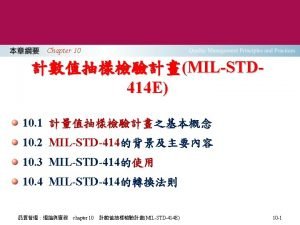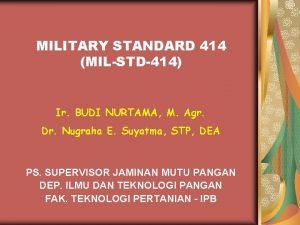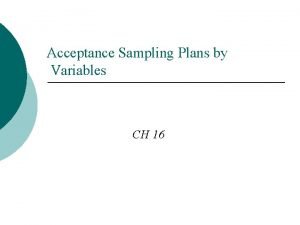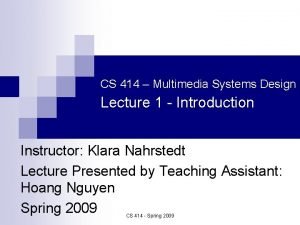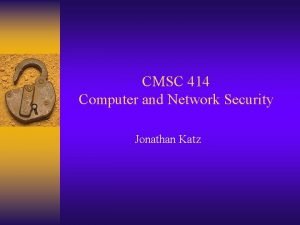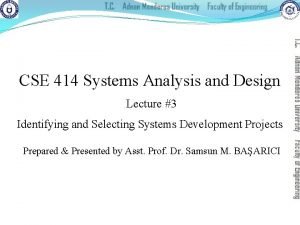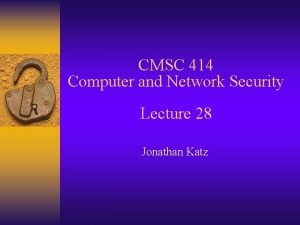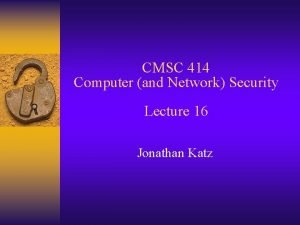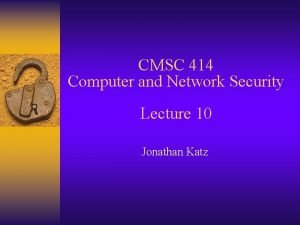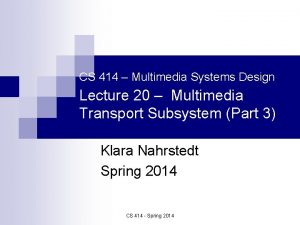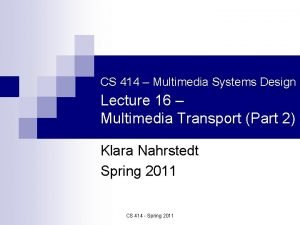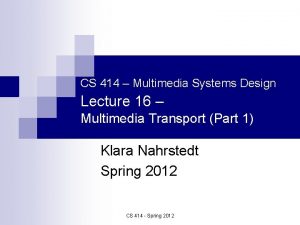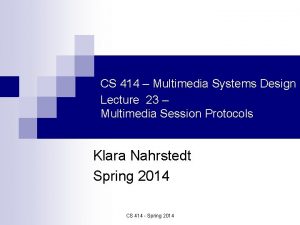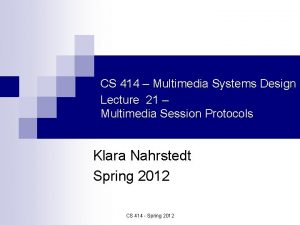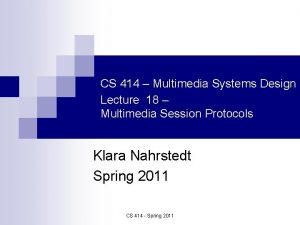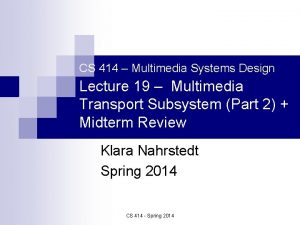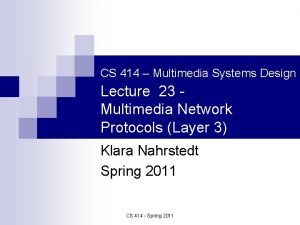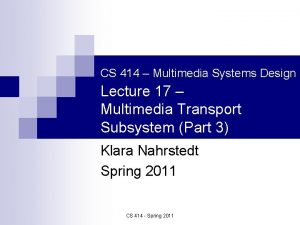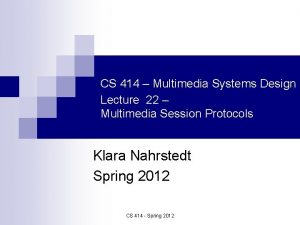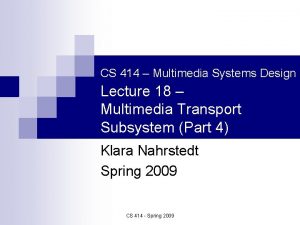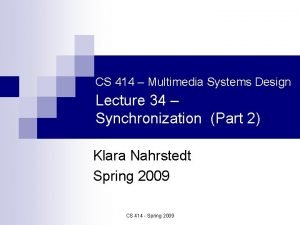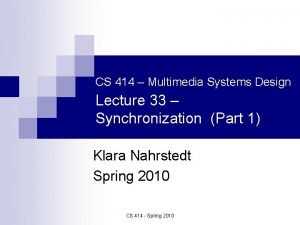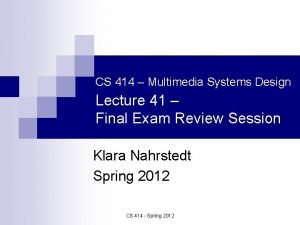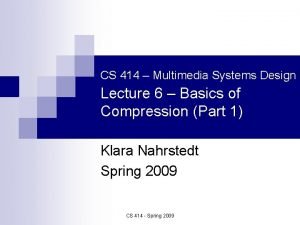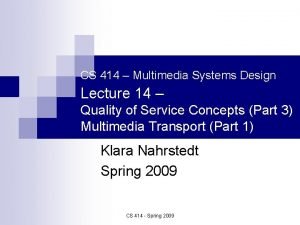CS 414 Multimedia Systems Design Lecture 24 Multimedia






















- Slides: 22

CS 414 – Multimedia Systems Design Lecture 24 – Multimedia Session Protocols (Layer 4 -5) Klara Nahrstedt Spring 2009 CS 414 - Spring 2009

Administrative MP 2 demonstrations 5 -7 pm in 216 SC, March 2 n HW 1 is out, deadline March 6, midnight n ¨ Individual effort!!! (take it as a midterm preparation) n Midterm, March 9 11 -11: 50 am in class All topics/lectures until February 27, i. e. , the material covered this week March 2 -9 will not be on the midterm ¨ You can bring calculator and 1 page of cheat-sheet (otherwise, exam is closed book, closed notes) ¨ CS 414 - Spring 2009

Internet Multimedia Protocol Stack APPLICATION Media encaps (H. 264, MPEG-4) RTSP SIP RSVP Layer 5 (Session) RTCP RTP KERNEL TCP UDP IP Version 4, IP Version 6 AAL 5 AAL 3/4 Layer 4 (Transport) Layer 3 (Network) Layer 2 (Link/MAC) Ethernet ATM CS 414 - Spring 2009

Service Requirements for Realtime Flows (Voice/Video) Sequencing n Intra-media synchronization n Inter-media synchronization n Payload identification n Frame indication n CS 414 - Spring 2009

Real-time Transmission Protocol (RTP) n n RTP provides end-to-end transport functions suitable for real-time audio/video applications over multicast and unicast network services RTP companion protocol – Real-time Transport Control Protocol (RTCP) RTP RTCP User Datagram Protocol Internet Protocol Ethernet 802. 13 or Wi-Fi 802. 11 PHY (Wired or Wireless) CS 414 - Spring 2009 Layer 4

Relation between RTP and RTCP Application Decoding Coding RTP RTCP Application Coding RTCP UDP/IP CS 414 - Spring 2009 Decoding RTP

RTCP: Control and Management n Out-of-band control information for RTP flow. ¨ Monitors Qo. S for RTP in the delivery and packaging of multimedia data ¨ Used periodically to transmit control packets to participants in a streaming multimedia session. ¨ Provides feedback on the quality of service being provided by RTP. ¨ Gathers statistics on media connection n n Bytes sent, packets sent, lost packets, jitter, feedback and round trip delay. Application may use this information to increase the quality of service, perhaps by limiting flow or using a different codec. CS 414 - Spring 2009

RTCP Functions n There are several type of RTCP packets: ¨ Sender report packet, ¨ Receiver report packet, ¨ Source Description RTCP Packet, ¨ Goodbye RTCP Packet and ¨ Application Specific RTCP packets. n RTCP itself does not provide any flow encryption or authentication means. SRTCP protocol can be used for that purpose. CS 414 - Spring 2009

RTP Services n Payload Type Identification ¨ Determination of media coding ¨ Source identification ¨ RTP works with Profiles n n Profile defines a set of payload type codes and their mappings to payload formats Sequence numbering ¨ Error n Time-stamping ¨ Time n detection monitoring, synchronization, jitter calculation Delivery monitoring CS 414 - Spring 2009

RTP Message MAC header IP header UDP header RTP message 0 0 0 0 0 1 1 1 1 1 2 2 2 2 2 3 3 0 1 2 3 4 5 6 7 8 9 0 1 Ver P X CC M PT Sequence Number Timestamp SSRC CSRC [0. . 15] : : : Ver – Version 2 P – Padding X – Extension, if set, the fixed head is followed by exactly one header extension CC – CSRC count M – Marker – intended to allow significant events such as frame boundaries to be marked (defined by profile) PT – Payload type SSRS – synchronization source, CSRC – contribution source CS 414 - Spring 2009

RTP Services – Support of Heterogeneity n Mixer service ¨ Allows for resynchronization of incoming audio packets ¨ Reconstructs constant 20 ms spacing generated by sender ¨ Mixes reconstructed audio streams into single stream ¨ Translates audio encoding to lower bandwidth ¨ Forwards lower bandwidth packet streams n Translator service ¨ Allows for translation between IP and other high speed protocols ¨ May change encoding data CS 414 - Spring 2009

Difference between Mixers and Translators S 3 S 1 M 1 T S 2 S 4 CS 414 - Spring 2009 M 2 R 1

Payload Formats n Static Payload formats ¨ Established in RTP Profile ¨ Payload type 0 : = µ-law audio codec n Dynamic Payload formats ¨ Applications agree per session on payload format ¨ H. 263, JPEG, MPEG CS 414 - Spring 2009

Session Management (Layer 5) n n Important part of multimedia communication Separates control aspects from transport aspects SESSION MANAGER Participant Management Conference control Session Control Configuration control Session Control Protocol (e. g. , RTSP) Media control Presentation data communication whiteboard Continuous data communication video Continuous data communication audio CS 414 - Spring 2009

Session Manager n Tasks: ¨ Membership control ¨ Monitoring of shared workspace ¨ Coordination of Media control management ¨ Exchange of Qo. S parameters ¨ Conference control management – establishment, modification, termination CS 414 - Spring 2009

Session Control n Session Described by ¨ Session n n state Name of session, start, valid policies Session management – two steps for state processing ¨ Establishment of session ¨ Modification of session CS 414 - Spring 2009

Session Control n Conference Control ¨ Centralized n or distributed approach Media Control ¨ Synchronization n Configuration Control ¨ Negotiation of Qo. S parameters, admission control and reservation/allocation of resources n Membership Control ¨ Invitation of users; registration of users, change of membership CS 414 - Spring 2009

Real-Time Streaming Protocol (RTSP) n n Application Protocol for Control of multimedia streams This is not an application data transmission protocol, just remote control protocol between client and server Audio Video Decoder Session Control RTSP RTP Audio video Coder RTP CLIENT SERVER CS 414 - Spring 2009

RTSP n n Approved as Internet Draft, February 2, 1998, authors H. Schulzrinne, A. Rao, R. Lanphier Enables controlled, on-demand delivery of realtime data such as audio and video Intends to control multiple data delivery sessions Provides means for choosing delivery channels ¨ UDP ¨ Multicast UDP, ¨ TCP CS 414 - Spring 2009

RTSP Methods Request Direction Description OPTIONS S <-> C Determine capabilities of server (S) or client (C) DESCRIBE C -> S Get description of media stream ANNOUNCE S <-> C Announce new session description SETUP C -> S Create media session RECORD C -> S Start media recording PLAY C -> S Start media delivery PAUSE C -> S Pause media delivery REDIRECT S -> C Use other server TEARDOWN C -> S Destroy media session SET_PARAMETER S <-> C Set server or client parameter GET_PARAMETER S <-> C Read server or client parameter CS 414 - Spring 2009

RTSP Extensions n Timing ¨ RTSP needs to hide latency variations ¨ PLAY request may contain information about when request is to be executed n Three types of timestamps ¨ SMPTE n Format: hours: minutes: seconds: frames ¨ Normal n (the same as in TV production) play time Measured relative to beginning of stream and expressed in ours, minutes, seconds and fractions of second ¨ Absolute n time Wall clock CS 414 - Spring 2009

Conclusion n n RTP usage – in several application audio and video tools (vat, vic) RTP follows the principle of application level framing and integrated layer processing RTP/UDP/IP is being used by the current streaming session protocols such as RTSP Session protocols are actually negotiation/session establishment protocols that assist multimedia applications Multimedia applications such as Quick. Time, Real Player and others use them CS 414 - Spring 2009
 01:640:244 lecture notes - lecture 15: plat, idah, farad
01:640:244 lecture notes - lecture 15: plat, idah, farad 0 414
0 414 Military standard 414
Military standard 414 Mil std 414
Mil std 414 414 climate change
414 climate change Cs 414
Cs 414 Cmsc414 umd
Cmsc414 umd Cse414
Cse414 Gcd of 414 and 662
Gcd of 414 and 662 Cmsc 414
Cmsc 414 Cmsc 414
Cmsc 414 Cmsc 414
Cmsc 414 Operating systems lecture notes
Operating systems lecture notes Lecture sound systems
Lecture sound systems Lecture sound systems
Lecture sound systems Multimedia becomes interactive multimedia when
Multimedia becomes interactive multimedia when Examples of non linear multimedia
Examples of non linear multimedia Chapter 1 introduction to multimedia
Chapter 1 introduction to multimedia Esa multimedia.esa.int./multimedia/virtual-tour-iss
Esa multimedia.esa.int./multimedia/virtual-tour-iss Reinforcement lap lengths eurocodes
Reinforcement lap lengths eurocodes Elemen urban design
Elemen urban design Elements and principles of interior design ppt
Elements and principles of interior design ppt Lecture hall acoustics
Lecture hall acoustics

